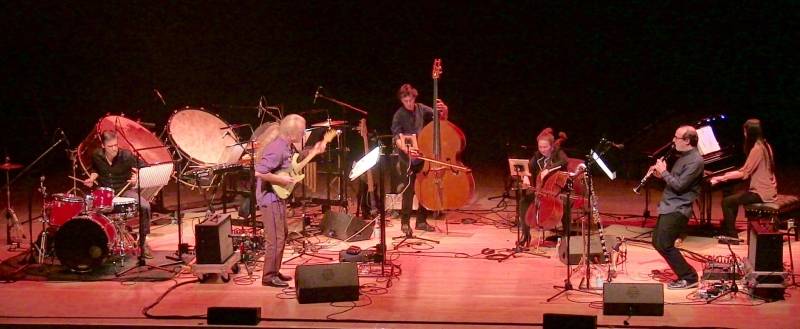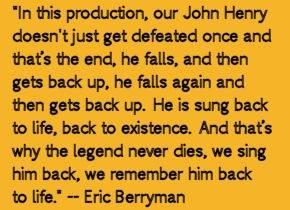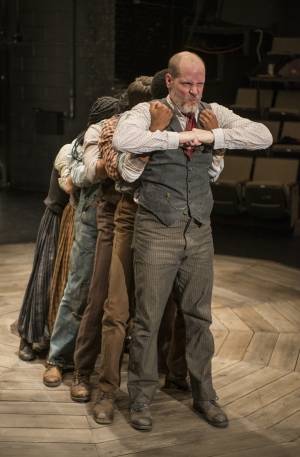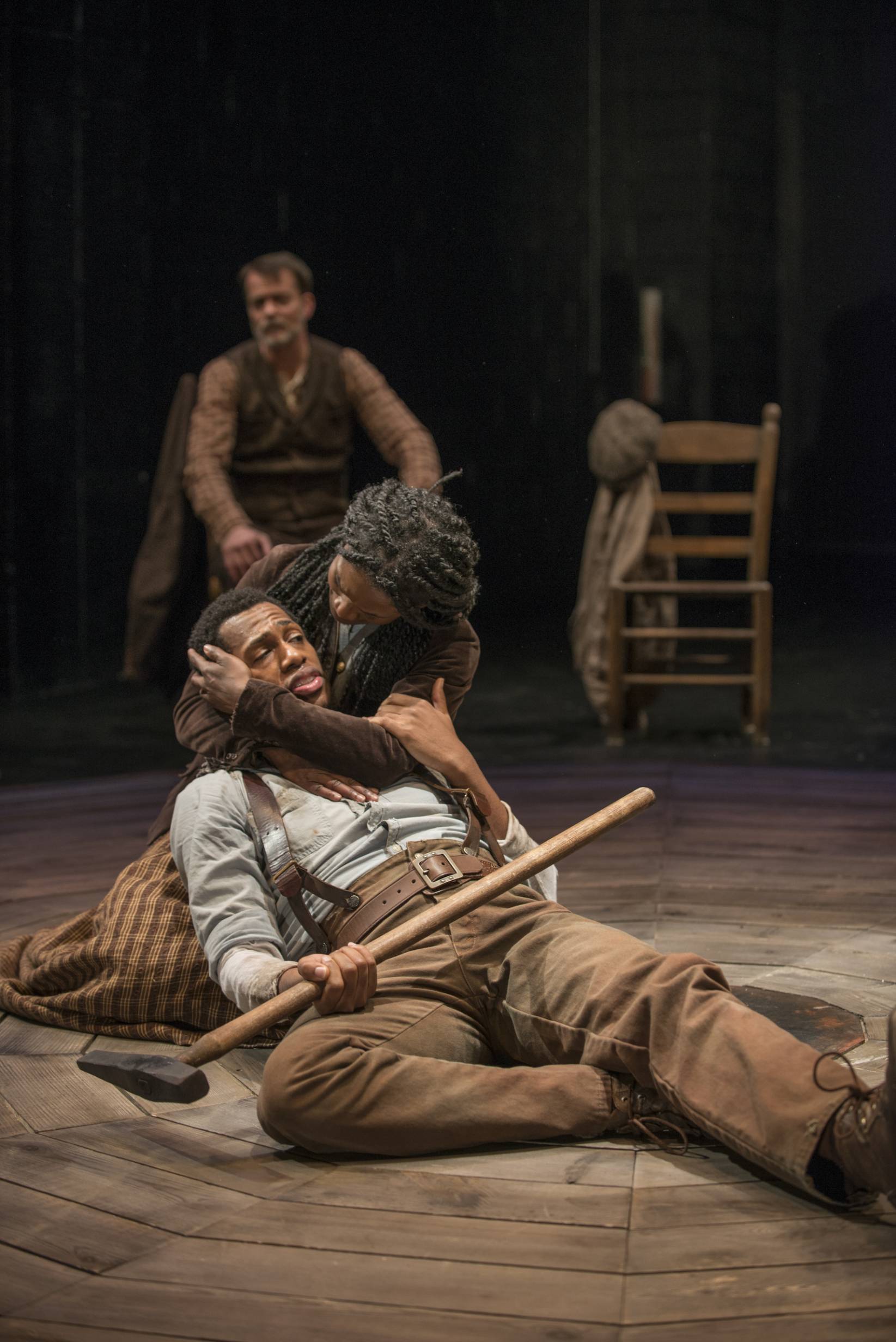Next Saturday, September 26th, the Krannert Center for the Performing Arts (KCPA) will premiere a never-before seen incarnation of the John Henry legend that was commissioned specifically for this event. A result of extraordinary cooperation and hard work itself, Steel Hammer blends input from our own residents with the brilliance of composer Julia Wolfe and her ensemble the Bang On a Can All-Stars, as well as the talents of SITI Company actors and its director, Anne Bogart for a premiere that should not be missed.

 While Wolfe’s cantata has existed since 2009, it was not recorded until just last year. Even then, the piece featured only the sextet of musicians and a trio of singers. The SITI Company approached Krannert with whom there has been a long-standing relationship, to see if there was interest in sponsoring a collaborative piece between the existing Steel Hammer as performed by Bang On a Can All-Stars with dialogue and movement created by the acting collective. KCPA and SITI had been working together on a grant called “Making Communities Visible” funded by the Doris Duke Charitable Foundation, and they found ways to bring this community outreach into the development of the new work. Scripts were written, actors cast, movements choreographed and the play was staged at the Humana Festival in 2014, set to a recording of the music. Each part of the work, music and theatre, has existed individually, but this week, cast members and musicians will be exploring the space in the Cowell Playhouse and the entire piece will come together for the first time on Saturday, after only a week of rehearsals.
While Wolfe’s cantata has existed since 2009, it was not recorded until just last year. Even then, the piece featured only the sextet of musicians and a trio of singers. The SITI Company approached Krannert with whom there has been a long-standing relationship, to see if there was interest in sponsoring a collaborative piece between the existing Steel Hammer as performed by Bang On a Can All-Stars with dialogue and movement created by the acting collective. KCPA and SITI had been working together on a grant called “Making Communities Visible” funded by the Doris Duke Charitable Foundation, and they found ways to bring this community outreach into the development of the new work. Scripts were written, actors cast, movements choreographed and the play was staged at the Humana Festival in 2014, set to a recording of the music. Each part of the work, music and theatre, has existed individually, but this week, cast members and musicians will be exploring the space in the Cowell Playhouse and the entire piece will come together for the first time on Saturday, after only a week of rehearsals.
One of the most amazing aspects of Steel Hammer is the multitude of sources from which it is drawn, including those within our very own community. For the past two years, company members of SITI have been traveling from New York to C-U to hold panel discussions, workshops, and classes to share the educational and enriching benefits of the arts. The ultimate goal has been to build a sustainable model for community-wide participation in the arts: one such result is the upcoming “Dreamgirls Revue” being put on by BBL/Mo’ Betta Music this October. Just recently, in July, residents had direct input into the development of Steel Hammer by answering questions about their initial exposure to the John Henry legend, and talking about their personal interpretations. Director Anne Bogart was present at the panel, and found her concepts and ideas about labor, work, and legend being shaped and challenged by all of the ideas being shared. Even though the piece is mostly complete, our community’s input will not stop now, after the performance, there will be a panel where audience members can ask questions and share ideas about the work.
 Aside from the multitude of voices from our community, myriad sources have fed this work. Anne Bogart asked four different playwrights to write a different version of the script without consulting each other, intentionally envisioning a quantum approach, with each script unique and personal to the writer. Julia Wolfe cites over 200 versions of the ballad for her choral text; to her, one of the most intriguing things about the legend was the endless interpretations and how they provide a wealth of themes to explore. When asked how this plethora of sources affects his portrayal of John Henry, actor Eric Berryman explained, “…there is such a fuzzy composite of this man, that any attempt to fit into one preconceived mold is unnecessary on my part. The legend begs for minute transformation which will in fact pull us closer to the truth than away from it.” Both composer and director seem to focus on this particular idea: that through the distillation of all the input, the audience will come to find a personal, resonant truth.
Aside from the multitude of voices from our community, myriad sources have fed this work. Anne Bogart asked four different playwrights to write a different version of the script without consulting each other, intentionally envisioning a quantum approach, with each script unique and personal to the writer. Julia Wolfe cites over 200 versions of the ballad for her choral text; to her, one of the most intriguing things about the legend was the endless interpretations and how they provide a wealth of themes to explore. When asked how this plethora of sources affects his portrayal of John Henry, actor Eric Berryman explained, “…there is such a fuzzy composite of this man, that any attempt to fit into one preconceived mold is unnecessary on my part. The legend begs for minute transformation which will in fact pull us closer to the truth than away from it.” Both composer and director seem to focus on this particular idea: that through the distillation of all the input, the audience will come to find a personal, resonant truth.
That truth is not exclusively political nor work-related, despite the pun in this article’s title. It certainly cannot be ignored, especially with a plot-arc of one man taking on industrialization’s attempt to replace human labor with machines. Even with worker’s rights, wages, employment opportunities and socio-economic climate in the forefront of our cultural consciousness, Berryman speaks about personal  impact and lasting memory – the triumph of true immortality. The director, saying, “I have become increasingly sensitive to the toll of hard labor not only on the body but on the soul and wellbeing of workers. But work is not only in steel mills or factories. Those of us who slave over our computers, stop taking lunch breaks and work late hours are also the victims,” feels this experience has changed her opinion of labor. However, she was convinced by some C-U residents to avoid creating a plodding, didactic political piece, emphasizing, “…they felt that they needed to create something celebratory. That this sense of celebration is the only thing that can do any good.” From growing up in Northern Appalachia and going to college in the Midwest, the composer gives the impression that she’s seen her share of hard work and experienced the work ethic upon which we pride ourselves, that we as a country claim as our true legacy, and her work truly celebrates.
impact and lasting memory – the triumph of true immortality. The director, saying, “I have become increasingly sensitive to the toll of hard labor not only on the body but on the soul and wellbeing of workers. But work is not only in steel mills or factories. Those of us who slave over our computers, stop taking lunch breaks and work late hours are also the victims,” feels this experience has changed her opinion of labor. However, she was convinced by some C-U residents to avoid creating a plodding, didactic political piece, emphasizing, “…they felt that they needed to create something celebratory. That this sense of celebration is the only thing that can do any good.” From growing up in Northern Appalachia and going to college in the Midwest, the composer gives the impression that she’s seen her share of hard work and experienced the work ethic upon which we pride ourselves, that we as a country claim as our true legacy, and her work truly celebrates.
 Combining that sense of celebration with hard work, however, has resulted in a theatre piece that is by all reports, taxing for every performer. It’s impossible to read an article or review of Julia Wolfe’s work that does not mention how physically demanding her music is to play for instrumentalists, which makes it unsurprising that her search for something “quintessentially American” led her to material revolving around labor and inspired grueling demands upon the actors. She was excited to see the staging, knowing that SITI tends to incorporate a lot of movement within their pieces. Anne Bogart of SITI was interested in the actors’ fatigue, and wanted “real rather than acted exhaustion.” Unfortunately, this began to lead to some injuries and overexertion, so the staging was modified in order to compensate. Regardless of the modifications, images from the initial performance give the impression that it will leave every spectator’s heart racing, though both emotion and the thrill of getting caught up in the action.
Combining that sense of celebration with hard work, however, has resulted in a theatre piece that is by all reports, taxing for every performer. It’s impossible to read an article or review of Julia Wolfe’s work that does not mention how physically demanding her music is to play for instrumentalists, which makes it unsurprising that her search for something “quintessentially American” led her to material revolving around labor and inspired grueling demands upon the actors. She was excited to see the staging, knowing that SITI tends to incorporate a lot of movement within their pieces. Anne Bogart of SITI was interested in the actors’ fatigue, and wanted “real rather than acted exhaustion.” Unfortunately, this began to lead to some injuries and overexertion, so the staging was modified in order to compensate. Regardless of the modifications, images from the initial performance give the impression that it will leave every spectator’s heart racing, though both emotion and the thrill of getting caught up in the action.
The various source material; the cooperation of musicians, actors, and the C-U community; the subject matter and physicality of the work will all weave together to create an unprecedented night of theatre. Berryman looks forward to the audience engagement lending its pulse to the performance, and Wolfe states, “I think that one of the strengths is that this production does not fit neatly into either the theater experience or concert experience. It is a kind of expanded way of telling the story.”
This remarkable and unique experience will take place on Saturday, September 26th at 7:30 p.m. in the Colwell Playhouse of the Krannert Center for the Performing Arts. Reserve a seat online or call the Ticket Office at 1-800-KCPATIX (527-2849) or locally at 217-333-6280
Theatre photographs by Michael Brosilow, all courtesy of SITI Company and Krannert Center for the Performing Arts.








